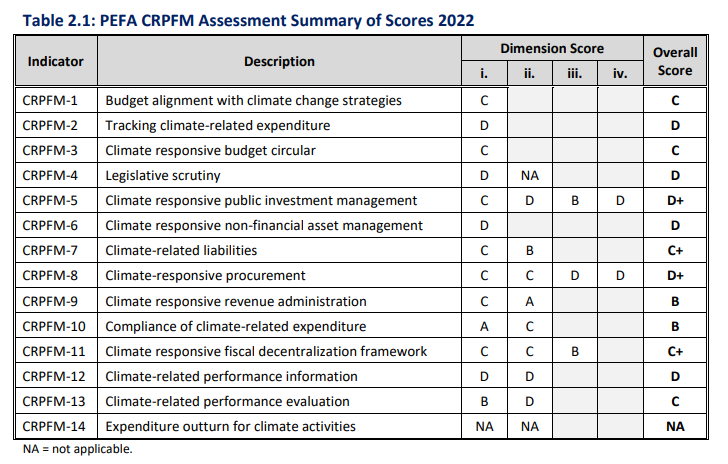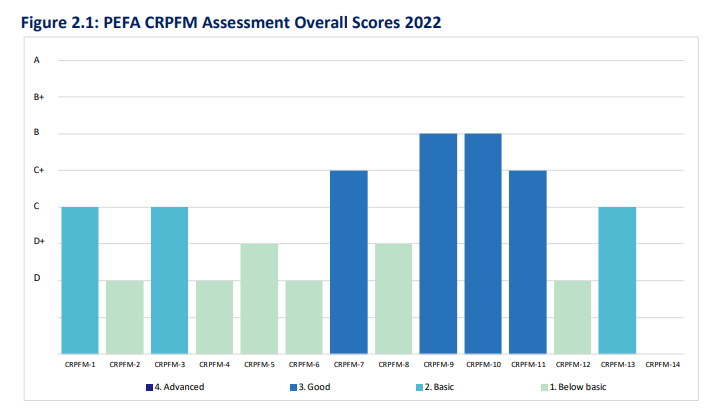Bhutan CRPFM 2023
1. INTRODUCTION
1.1 Purpose
1.1. This Climate Responsive Public Financial Management (CRPFM) assessment of the Royal Government of Bhutan (RGoB) is conducted using the ‘CRPFM Framework (PEFA Climate)’.1 The purpose is to review the extent to which the RGoB’s PFM system supports and fosters the implementation of climate change policies, i.e. if it is “climate responsive”.
1.2. The arrangements described in Volume I (PFM assessment) as regards funding, peer review, time coverage,2 scope, etc., similarly apply to the CRPFM assessment.
1.3. The CRPFM assessment was conducted concurrently with the PFM assessment so as to collect specific information on the extent to which the RGoB’s PFM system is climate responsive, and so as to enable promoting climate-related aspects going forward based on the assessment findings.
1.2 Climate Profile
1.4. The climate of Bhutan is exceptionally diverse and varies substantially from one district to another due to dramatic changes in topography, elevation, and altitude. The country has three climatic zones: a) the southern plains with a typical subtropical climate with high humidity and heavy rainfall; b) the central belt of flat valleys characterized by cool winters and hot summers with moderate rainfall; and, c) the high valleys with cold winters and cool summers. The land over 5000m is permanently covered with snow and glaciers.
1.5. Bhutan receives about 70% of the precipitation during monsoons, which last from late June through late September. The rain bearing clouds which originate from the Bay of Bengal travel north towards the Bhutan Himalayas.
1.6. The annual precipitation ranges widely across the country. The northern region gets about 40 mm of annual precipitation, mostly in the form of snow. The temperate central valley receives about 1,000 mm of rainfall, while the southern region gets about 1,500 mm of rain annually.
A. Legal and Policy Framework
1.7. The Climate Change Policy of the Kingdom of Bhutan 2020 anchored in four policy statements: carbon neutral development, resilience to climate change, ensuring means of implementation, and effective and coordinated actions. The Policy is notable for clearly outlining institutional arrangements for climate change action and implementation, including designating the Climate Change Coordination Committee (or C4) as a technical body for discussion and coordination, and the National Environment Commission (NEC) as responsible for monitoring implementation together with relevant government ministries and agencies. The Policy is formulated to respond to particular provisions of the following legal instruments:
i) Constitution of the Kingdom of Bhutan: Article 9.2 states the need to “strive to promote those conditions that will enable the pursuit of Gross National Happiness”, and Article 5 includes the obligation for the Government to “protect, conserve and improve the pristine environment and safeguard the biodiversity of the country” and “ensure a safe and healthy environment”.
ii) National Environment Protection Act 2007: This document is aligned to the principles in the Act and also supported the implementation of mandates and functions of the National Environment Commission (NEC) and its Secretariat in implementing obligations under multilateral agreements, and in facilitating the implementation of actions by stakeholder agencies.
iii) The Environment Assessment Act 2000: This Act establishes procedures for the assessment of potential effects of strategic plans, policies, programs and projects on the environment, and for the determination of policies and measures to reduce potential adverse effects and to promote environmental benefits.
iv) The Water Act of Bhutan 2011: Climate change has huge impact on water bodies. This Act aims to ensure that the water resources are protected, conserved and/or managed in an economically efficient, socially equitable and environmentally sustainable manner.
v) The Waste Prevention and Management Act of Bhutan 2009: The purpose of the Act shall be to protect and sustain human health through protection of the environment.
vi) Public Finance Act (PFA) 2007: Climate financing shall be governed by Chapter VI of the PFA 2007.
2. ASSESSMENT FINDINGS AND WAY FORWARD
2.1. This chapter presents the main findings of the assessment compared with the PEFA CRPFM framework, shows the indicator-level scores across the three main budgetary outcomes (aggregate fiscal discipline, strategic allocation of resources, and efficient service delivery), and provides a brief list of potential areas for improvement going forward.
2.1 Main findings
2.2. The dimension-level scores and the resulting indicator-level scores are shown in the table below.

2.3. Out of 14 indicators, two scored “B” (CRPFM-9 and 10), two scored “C+” (CRPFM-7 and 11), three scored “C” (CRPFM-1, 3 and 13), two scored “D+” (CRPFM-5 and 8), four scored “D” (CRPFM-2, 4, 6 and 12), and one indicator was deemed “NA” (CRPFM-14). 2.4. Out of the 29 dimensions, the majority of scores were “C” (10) and “D” (10), while there was two “A” scores, four “B” scores, and three “NA”.
2.5. The indicator-level scores are shown graphically in the figure below.

2.6. Four indicators – climate-related liabilities (CRPFM-7), climate responsive revenue administration (CRPFM-9), compliance of climate-related expenditure (CRPFM-10), and climate responsive fiscal decentralization framework (CRPFM-11) – show ‘good’ performance. This means that climate change issues and the policy response are partially mainstreamed in relevant PFM institutions, processes, and systems.
2.7. Three indicators – budget alignment with climate change strategies (CRPFM-1), climate responsive budget circular (CRPFM-3), and climate-related performance evaluation (CRPFM-13) – have a ‘basic’ performance. This means that initial efforts have been made to mainstream climate change issues and policy responses in the relevant PFM institutions, processes, and systems.
2.8. The remaining six indicators (CRPFM-2, 4, 5, 6, 8 and 12) have a ‘below basic’ performance, which in effect means that efforts to mainstream climate change issues and policy responses in relevant PFM institutions, processes, and systems remains to be started.





